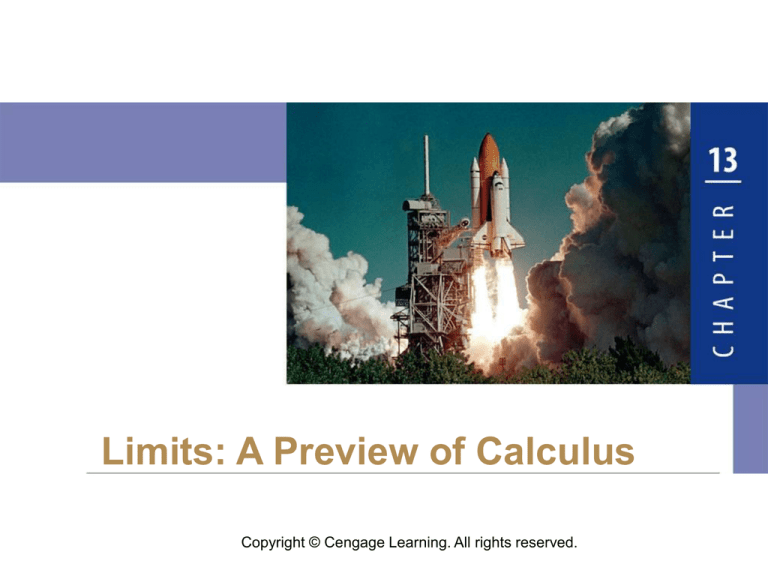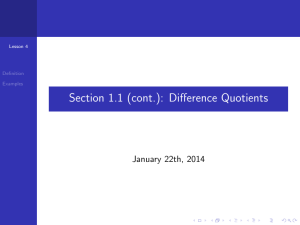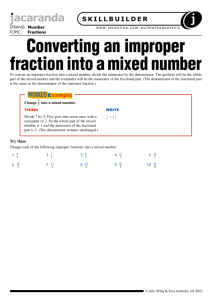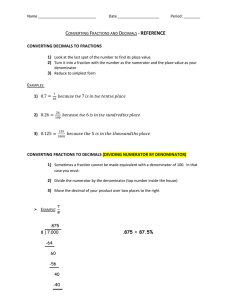
Limits: A Preview of Calculus
Copyright © Cengage Learning. All rights reserved.
13.2
Finding Limits Algebraically
Copyright © Cengage Learning. All rights reserved.
Objectives
► Limit Laws
► Applying the Limit Laws
► Finding Limits Using Algebra and the Limit Laws
► Using Left- and Right-Hand Limits
3
Limit Laws
4
Limit Laws
We use the following properties of limits, called the Limit
Laws, to calculate limits.
5
Limit Laws
These five laws can be stated verbally as follows:
1. The limit of a sum is the sum of the limits.
2. The limit of a difference is the difference of the limits.
3. The limit of a constant times a function is the constant
times the limit of the function.
4. The limit of a product is the product of the limits.
5. The limit of a quotient is the quotient of the limits
(provided that the limit of the denominator is not 0).
It’s easy to believe that these properties are true.
6
Limit Laws
For instance, if f(x) is close to L and g(x) is close to M, it is
reasonable to conclude that f(x) + g(x) is close to L + M.
This gives us an intuitive basis for believing that Law 1 is
true.
7
Limit Laws
If we use Law 4 (Limit of a Product) repeatedly with
g(x) = f(x), we obtain the following Law 6 for the limit of a
power. A similar law holds for roots.
In words, these laws say the following:
6. The limit of a power is the power of the limit.
7. The limit of a root is the root of the limit.
8
Example 1 – Using the Limit Laws
Use the Limit Laws and the graphs of f and g in Figure 1 to
evaluate the following limits if they exist.
(a)
[f(x) + 5g(x)]
(b)
(c)
(d)
Figure 1
[f(x)g(x)]
[f(x)]3
9
Example 1 – Solution
(a) From the graphs of f and g we see that
f(x) = 1 and
g(x) = –1
Therefore we have
[f(x) + 5g(x)] =
=
f(x) +
f(x) + 5
[5g(x)]
g(x)
Limit of a Sum
Limit of a Constant
Multiple
= 1 + 5(–1)
= –4
10
Example 1 – Solution
cont’d
(b) We see that
f(x) = 2. But
g(x) does not exist
because the left- and right-hand limits are different:
g(x) = –2
g(x) = –1
So we can’t use Law 4 (Limit of a Product). The given
limit does not exist, since the left-hand limit is not equal
to the right-hand limit.
(c) The graphs show that
f(x) 1.4
and
g(x) = 0
11
Example 1 – Solution
cont’d
Because the limit of the denominator is 0, we can’t use
Law 5 (Limit of a Quotient).
The given limit does not exist because the denominator
approaches 0 while the numerator approaches a
nonzero number.
(d) Since
= 2, we use Law 6 to get
[f(x)]3 =
Limit of a Power
= 23
=8
12
Applying the Limit Laws
13
Applying the Limit Laws
In applying the Limit Laws, we need to use four special
limits.
14
Example 2 – Using the Limit Laws
Evaluate the following limits, and justify each step.
(a)
(2x2 – 3x + 4)
(b)
Solution:
(a)
(2x2 – 3x + 4)
=
(2x2) –
(3x) +
4
Limits of a Difference
and Sum
15
Example 2 – Solution
=2
x2 – 3
x+
= 2(52) – 3(5) + 4
4
cont’d
Limit of a Constant Multiple
Special Limits 3, 2, and 1
= 39
(b) We start by using Law 5, but its use is fully justified only
at the final stage when we see that the limits of the
numerator and denominator exist and the limit of the
denominator is not 0.
16
Example 2 – Solution
cont’d
Limit of a Quotient
Limits of Sums,
Differences, and
Constant Multiples
Special Limits 3,
2, and 1
17
Applying the Limit Laws
Functions with this direct substitution property are called
continuous at a.
18
Example 3 – Finding Limits by Direct Substitution
Evaluate the following limits.
(a)
(2x3 – 10x – 8)
(b)
Solution:
(a) The function f(x) = 2x3 – 10x – 8 is a polynomial, so we
can find the limit by direct substitution:
(2x3 – 10x – 8) = 2(3)3 – 10(3) – 8
= 16
19
Example 3 – Solution
cont’d
(b) The function f(x) =
is a rational function, and
x = –1 is in its domain (because the denominator is
not zero for x = –1).
Thus, we can find the limit by direct substitution:
20
Finding Limits Using Algebra
and the Limit Laws
21
Example 4 – Finding a Limit by Canceling a Common Factor
Find
Solution:
Let f(x) = (x – 1)/(x2 – 1).
We can’t find the limit by substituting x = 1 because f(1)
isn’t defined. Nor can we apply Law 5 (Limit of a Quotient)
because the limit of the denominator is 0.
Instead, we need to do some preliminary algebra.
We factor the denominator as a difference of squares:
22
Example 4 – Solution
cont’d
The numerator and denominator have a common factor of
x – 1.
When we take the limit as x approaches 1, we have
x 1 and so x – 1 0.
Therefore we can cancel the common factor and compute
the limit as follows:
Factor
Cancel
23
Example 4 – Solution
cont’d
Let x 1
24
Using Left- and Right-Hand Limits
25
Using Left- and Right-Hand Limits
Some limits are best calculated by first finding the left- and
right-hand limits.
The following theorem says that a two-sided limit exists if
and only if both of the one-sided limits exist and are equal.
When computing one-sided limits, we use the fact that the
Limit Laws also hold for one-sided limits.
26
Example 7 – Comparing Right and Left Limits
Show that
|x| = 0.
Solution:
We know that
Since |x| = x for x > 0, we have
|x| =
x=0
For x < 0, we have |x| = –x, so
|x| =
(–x) = 0
27
Example 7 – Solution
cont’d
Therefore
|x| = 0
Figure 2
28








